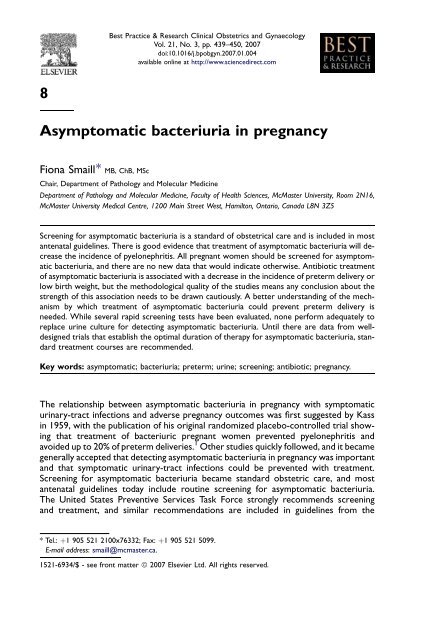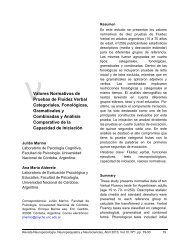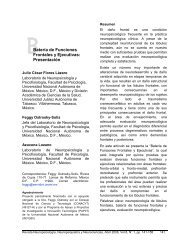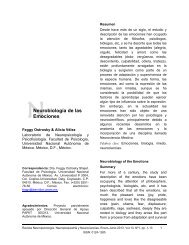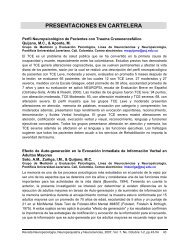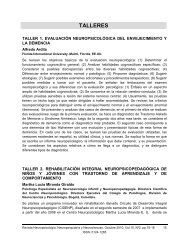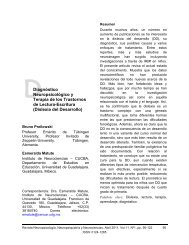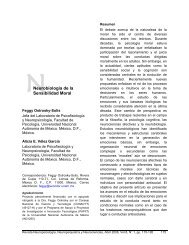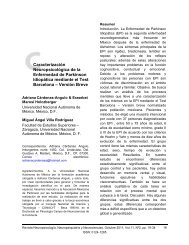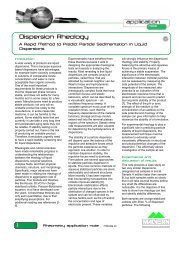8 Asymptomatic bacteriuria in pregnancy
8 Asymptomatic bacteriuria in pregnancy
8 Asymptomatic bacteriuria in pregnancy
You also want an ePaper? Increase the reach of your titles
YUMPU automatically turns print PDFs into web optimized ePapers that Google loves.
Best Practice & Research Cl<strong>in</strong>ical Obstetrics and GynaecologyVol. 21, No. 3, pp. 439–450, 2007doi:10.1016/j.bpobgyn.2007.01.004available onl<strong>in</strong>e at http://www.sciencedirect.com8<strong>Asymptomatic</strong> <strong>bacteriuria</strong> <strong>in</strong> <strong>pregnancy</strong>Fiona Smaill* MB, ChB, MScChair, Department of Pathology and Molecular Medic<strong>in</strong>eDepartment of Pathology and Molecular Medic<strong>in</strong>e, Faculty of Health Sciences, McMaster University, Room 2N16,McMaster University Medical Centre, 1200 Ma<strong>in</strong> Street West, Hamilton, Ontario, Canada L8N 3Z5Screen<strong>in</strong>g for asymptomatic <strong>bacteriuria</strong> is a standard of obstetrical care and is <strong>in</strong>cluded <strong>in</strong> mostantenatal guidel<strong>in</strong>es. There is good evidence that treatment of asymptomatic <strong>bacteriuria</strong> will decreasethe <strong>in</strong>cidence of pyelonephritis. All pregnant women should be screened for asymptomatic<strong>bacteriuria</strong>, and there are no new data that would <strong>in</strong>dicate otherwise. Antibiotic treatmentof asymptomatic <strong>bacteriuria</strong> is associated with a decrease <strong>in</strong> the <strong>in</strong>cidence of preterm delivery orlow birth weight, but the methodological quality of the studies means any conclusion about thestrength of this association needs to be drawn cautiously. A better understand<strong>in</strong>g of the mechanismby which treatment of asymptomatic <strong>bacteriuria</strong> could prevent preterm delivery isneeded. While several rapid screen<strong>in</strong>g tests have been evaluated, none perform adequately toreplace ur<strong>in</strong>e culture for detect<strong>in</strong>g asymptomatic <strong>bacteriuria</strong>. Until there are data from welldesignedtrials that establish the optimal duration of therapy for asymptomatic <strong>bacteriuria</strong>, standardtreatment courses are recommended.Key words: asymptomatic; <strong>bacteriuria</strong>; preterm; ur<strong>in</strong>e; screen<strong>in</strong>g; antibiotic; <strong>pregnancy</strong>.The relationship between asymptomatic <strong>bacteriuria</strong> <strong>in</strong> <strong>pregnancy</strong> with symptomaticur<strong>in</strong>ary-tract <strong>in</strong>fections and adverse <strong>pregnancy</strong> outcomes was first suggested by Kass<strong>in</strong> 1959, with the publication of his orig<strong>in</strong>al randomized placebo-controlled trial show<strong>in</strong>gthat treatment of bacteriuric pregnant women prevented pyelonephritis andavoided up to 20% of preterm deliveries. 1 Other studies quickly followed, and it becamegenerally accepted that detect<strong>in</strong>g asymptomatic <strong>bacteriuria</strong> <strong>in</strong> <strong>pregnancy</strong> was importantand that symptomatic ur<strong>in</strong>ary-tract <strong>in</strong>fections could be prevented with treatment.Screen<strong>in</strong>g for asymptomatic <strong>bacteriuria</strong> became standard obstetric care, and mostantenatal guidel<strong>in</strong>es today <strong>in</strong>clude rout<strong>in</strong>e screen<strong>in</strong>g for asymptomatic <strong>bacteriuria</strong>.The United States Preventive Services Task Force strongly recommends screen<strong>in</strong>gand treatment, and similar recommendations are <strong>in</strong>cluded <strong>in</strong> guidel<strong>in</strong>es from the* Tel.: þ1 905 521 2100x76332; Fax: þ1 905 521 5099.E-mail address: smaill@mcmaster.ca.1521-6934/$ - see front matter ª 2007 Elsevier Ltd. All rights reserved.
440 F. SmaillInfectious Diseases Society of America, the National Institute for Cl<strong>in</strong>ical Excellence,the European Association of Urology, the Canadian Task Force on Preventive Care,and most recently from the Scottish Intercollegiate Guidel<strong>in</strong>es Network. 2–7There is, however, an ongo<strong>in</strong>g and vigorous debate on the role of asymptomatic<strong>bacteriuria</strong> <strong>in</strong> per<strong>in</strong>atal outcomes, but very little new evidence has accumulated s<strong>in</strong>cethe mid-1970s to address this issue. Questions also cont<strong>in</strong>ue to be raised about thevalue of rout<strong>in</strong>e screen<strong>in</strong>g for <strong>bacteriuria</strong> <strong>in</strong> populations where the prevalence of asymptomatic<strong>bacteriuria</strong> is low, given effective management of symptomatic ur<strong>in</strong>ary-tract <strong>in</strong>fectionsand improvements <strong>in</strong> per<strong>in</strong>atal care, and the recognition that other subcl<strong>in</strong>ical<strong>in</strong>fections that were not considered <strong>in</strong> the orig<strong>in</strong>al studies from the 1960s and 1970smay have been responsible for the <strong>in</strong>creased rate of prematurity seen. 8,9 Althoughthere is a plausible biological explanation for a mechanism by which asymptomatic<strong>bacteriuria</strong> might cause preterm labour, the experimental data to suggest causationare only weak. It is timely to critically review the evidence that <strong>in</strong>forms our currentmanagement of asymptomatic <strong>bacteriuria</strong> <strong>in</strong> <strong>pregnancy</strong> and to discuss areas where furthergood-quality research is needed. The reader is also referred to recent comprehensivereviews of ur<strong>in</strong>ary-tract <strong>in</strong>fections <strong>in</strong> <strong>pregnancy</strong> for additional <strong>in</strong>formation. 10–12SIGNIFICANCE OF BACTERIURIA IN PREGNANCYThere is good evidence that screen<strong>in</strong>g for and treatment of asymptomatic <strong>bacteriuria</strong>will decrease the <strong>in</strong>cidence of pyelonephritis. Comb<strong>in</strong><strong>in</strong>g data from more than 20 ofthe early descriptive studies from the 1960s, Whalley showed that symptomaticur<strong>in</strong>ary-tract <strong>in</strong>fections occurred <strong>in</strong> 30% of patients if asymptomatic <strong>bacteriuria</strong> wasuntreated, compared with 1.8% of non-bacteriuric controls. 13 Cohort studies haveconfirmed that the <strong>in</strong>cidence of pyelonephritis is low with rout<strong>in</strong>e prenatal screen<strong>in</strong>gfor asymptomatic <strong>bacteriuria</strong> compared to historical control groups. 14–17 In the mostrecent prospective longitud<strong>in</strong>al study over a 2-year period from 2000 to 2001, the <strong>in</strong>cidenceof hospitalization for acute pyelonephritis was 1.4%, less than the 3–4% ratereported <strong>in</strong> the early 1970s before screen<strong>in</strong>g for asymptomatic <strong>bacteriuria</strong> becamerout<strong>in</strong>e. 17A meta-analysis of 13 randomized or quasi-randomized controlled trials of antibiotictreatment versus no treatment for pregnant women with asymptomatic <strong>bacteriuria</strong>found that treatment substantially decreased the risk of the development of pyelonephritis(odds ratio (OR) 0.24, 95% confidence <strong>in</strong>terval (CI) 0.19, 0.32). 18 The methodologicalquality of the studies <strong>in</strong>cluded was, however, weak, and no study adequatelyaddressed selection bias. In less than half of the studies was the control group given a placebo,and performance and detection biases were not satisfactorily handled. Theresults, however, were highly consistent among studies, and the reduction <strong>in</strong> the<strong>in</strong>cidence of pyelonephritis was dramatic. It was estimated that the number of womenneeded to treat to prevent one episode of pyelonephritis was seven (CI 6, 9) andtreatment of asymptomatic <strong>bacteriuria</strong> would lead to approximately a 75% reduction<strong>in</strong> pyelonephritis.Although an association between asymptomatic <strong>bacteriuria</strong> and preterm deliveryhas been consistently shown, the <strong>in</strong>terpretation of this f<strong>in</strong>d<strong>in</strong>g rema<strong>in</strong>s controversialcompared with the widely accepted relationship between asymptomatic <strong>bacteriuria</strong>and pyelonephritis. F<strong>in</strong>d<strong>in</strong>gs from the Cardiff Birth Survey, which prospectively studied25,844 births, reported that asymptomatic <strong>bacteriuria</strong>, adjusted for demographic andsocial factors, was not associated with preterm delivery (OR 1.2, 95%CI 0.9, 1.5). 19
<strong>Asymptomatic</strong> <strong>bacteriuria</strong> <strong>in</strong> <strong>pregnancy</strong> 441However, when preterm births were categorized <strong>in</strong>to medically <strong>in</strong>dicated or spontaneouspreterm births, there was a significant association between <strong>bacteriuria</strong> and medically<strong>in</strong>dicated preterm births (OR 2.03; 95%CI 1.5, 2.8) but not for spontaneouspreterm births (OR1.07; 95%CI 0.78, 1.46) 20 , and the authors concluded that if asymptomatic<strong>bacteriuria</strong> does not progress to pyelonephritis it is not associated withpreterm birth.In a meta-analysis of 17 cohort studies that reported on the <strong>in</strong>cidence of low birthweight <strong>in</strong> pregnant women with or without <strong>bacteriuria</strong>, and four cohort studies wherethe outcomes <strong>in</strong>cluded preterm delivery, Romero et al concluded that there wasa strong association between untreated asymptomatic <strong>bacteriuria</strong> and low birthweight/preterm delivery, and that antibiotic treatment was effective <strong>in</strong> reduc<strong>in</strong>g the occurrenceof low-birth-weight <strong>in</strong>fants. 21 The cohort studies estimated that the risk oflow birth weight was reduced by about two thirds (typical relative risk 0.65; 95%CI0.57, 0.74), correspond<strong>in</strong>g to a 3.4 % (95%CI 1.8, 5.0) reduction <strong>in</strong> low-birth-weight<strong>in</strong>fants. The estimate was a little lower for the randomized trials (typical relativerisk 0.56; 95%CI 0.43, 0.73), but a reduction of 6.4% (CI 3.3, 9.5) <strong>in</strong> the rate of lowbirth weight was seen.In the Cochrane Review of antibiotic treatment for asymptomatic <strong>bacteriuria</strong> <strong>in</strong><strong>pregnancy</strong> that <strong>in</strong>cluded ten randomized or quasi-randomized controlled cl<strong>in</strong>ical trialswhere the outcome of preterm delivery or low birth-weight was reported, antibiotictreatment was shown to be associated with a reduction <strong>in</strong> this outcome (OR 0.60,95%CI 0.45, 0.80). 18 There is, however, disquiet over these results because of thepoor methodological quality of the studies <strong>in</strong>cluded <strong>in</strong> this review, as previously describedfor the outcome of pyelonephritis, as well as the <strong>in</strong>clusion of both a birthweight of
442 F. SmaillK<strong>in</strong>gdom concluded that there was a range of practices, with very few units cont<strong>in</strong>u<strong>in</strong>gto screen all patients for asymptomatic <strong>bacteriuria</strong>, and <strong>in</strong> this paper the authors questionedthe value of screen<strong>in</strong>g. 29PATHOPHYSIOLOGY AND MICROBIOLOGYThe rates of asymptomatic <strong>bacteriuria</strong> <strong>in</strong> pregnant and non-pregnant women are similar,but while asymptomatic <strong>bacteriuria</strong> <strong>in</strong> non-pregnant women is generally benign,obstruction to the flow of ur<strong>in</strong>e <strong>in</strong> <strong>pregnancy</strong> leads to stasis and <strong>in</strong>creases the likelihoodthat pyelonephritis will complicate asymptomatic <strong>bacteriuria</strong>. Pregnancy-<strong>in</strong>ducedphysiological changes <strong>in</strong> the ur<strong>in</strong>ary system that facilitate the progression of asymptomatic<strong>bacteriuria</strong> to acute pyelonephritis <strong>in</strong>clude progesterone-<strong>in</strong>duced dilatationof the ureters and renal pelvis, displacement of the ur<strong>in</strong>ary bladder from the pelvis<strong>in</strong>to the abdomen, and ur<strong>in</strong>ary stasis due to decreased ureteral and bladder tone. 30,31In all studies of asymptomatic <strong>bacteriuria</strong>, Escherichia coli is the most common organismassociated with <strong>bacteriuria</strong>, represent<strong>in</strong>g at least 80% of isolates, with othergram-negative rods and certa<strong>in</strong> gram-positive organisms – <strong>in</strong>clud<strong>in</strong>g Staphylococcussaprophyticus and enterococci – occasionally be<strong>in</strong>g isolated.Specific virulence determ<strong>in</strong>ants <strong>in</strong> uropathogenic stra<strong>in</strong>s of E. coli – <strong>in</strong>clud<strong>in</strong>g tox<strong>in</strong>sand adhes<strong>in</strong>s, pili or fimbriae that allow adherence to uroepithelial cells and preventbacteria from ur<strong>in</strong>ary lavage, allow<strong>in</strong>g for multiplication and tissue <strong>in</strong>vasion – are associatedwith <strong>in</strong>vasive <strong>in</strong>fection and pyelonephritis <strong>in</strong> <strong>pregnancy</strong>. However, the frequencyof virulence associated determ<strong>in</strong>ants are lower <strong>in</strong> E. coli associated with asymptomatic<strong>bacteriuria</strong> compared to pyelonephritis. 32 Only 22% of stra<strong>in</strong>s of E. coli isolated fromwomen with asymptomatic <strong>bacteriuria</strong> had the capacity to adhere to uroepithelial cellscompared with 75% <strong>in</strong> the group of women who developed acute pyelonephritis. It hasnot been prospectively studied whether those women colonized with a more virulentstra<strong>in</strong> are at an <strong>in</strong>creased risk of progression to symptomatic disease or other adverseper<strong>in</strong>atal outcomes compared with women colonized with a stra<strong>in</strong> that does not demonstratethese virulence determ<strong>in</strong>ants. Adherence is the s<strong>in</strong>gle marker most frequentlyassociated with progression to pyelonephritis. Although proposed asa means to identify a group of women at <strong>in</strong>creased risk of <strong>in</strong>vasive <strong>in</strong>fection, screen<strong>in</strong>gfor these virulent stra<strong>in</strong>s is still only a theoretical possibility.While group B streptococci (Streptococcus agalactiae) is uncommonly a cause oftrue ur<strong>in</strong>ary-tract <strong>in</strong>fection, its isolation from the ur<strong>in</strong>e <strong>in</strong> <strong>pregnancy</strong> does reflect heavyvag<strong>in</strong>al colonization. There is an association between group B streptococcal <strong>bacteriuria</strong>and preterm rupture of membranes, premature delivery, and early-onset neonatalsepsis. Ur<strong>in</strong>e colony counts lower than the typical values reported for asymptomatic<strong>bacteriuria</strong> (10 5 colony-form<strong>in</strong>g units (cfu)/mL) are probably important, and <strong>in</strong> the onerandomized trial that compared treatment with penicill<strong>in</strong> with no treatment for anycolony count of group B streptococcus isolated from the ur<strong>in</strong>e, there was a reduction<strong>in</strong> preterm rupture of membranes and preterm delivery with treatment. 33 Guidel<strong>in</strong>esfor the prevention of per<strong>in</strong>atal group B streptococcal disease recommend that womenwith group B streptococcal <strong>bacteriuria</strong> receive <strong>in</strong>trapartum antibiotic prophylaxis. 34Staphylococcus saprophyticus with a low colony count is a recognized cause of symptomaticur<strong>in</strong>e <strong>in</strong>fection <strong>in</strong> non-pregnant women; however, the importance of this organism<strong>in</strong> asymptomatic pregnant women has not been established, and it is<strong>in</strong>frequently reported <strong>in</strong> studies of <strong>bacteriuria</strong> <strong>in</strong> pregnant women. Staphylococcusaureus is not considered a typical uropathogen, and the <strong>in</strong>terpretation of its isolation
<strong>Asymptomatic</strong> <strong>bacteriuria</strong> <strong>in</strong> <strong>pregnancy</strong> 443from the ur<strong>in</strong>e of up to a third of pregnant women <strong>in</strong> a low-<strong>in</strong>come population fromNigeria requires further evaluation. 35Specialized culture techniques have identified anaerobic organisms and other fastidiousmicroorganisms <strong>in</strong> a large percentage of pregnant women, but the significance ofthese organisms from the ur<strong>in</strong>e and per<strong>in</strong>atal outcomes has not been systematicallystudied. 36 Up to 15% of pregnant women will have Ureaplasma urealyticum and Gardnerellavag<strong>in</strong>alis isolated from the bladder ur<strong>in</strong>e. At present, there is no evidence to rout<strong>in</strong>elyexam<strong>in</strong>e the ur<strong>in</strong>e for these organisms.EPIDEMIOLOGY OF BACTERIURIAThe prevalence of asymptomatic <strong>bacteriuria</strong> dur<strong>in</strong>g <strong>pregnancy</strong> ranges from about 2 to10%. While rates from most recent observational studies done <strong>in</strong> develop<strong>in</strong>g countriesfall with<strong>in</strong> this range 37–39 , the prevalence of asymptomatic <strong>bacteriuria</strong> was reported tobe as high as 86.6% <strong>in</strong> a study from Nigeria, although S. aureus, which is not typicallyrecognized as a uropathogen, made up over a third of the isolates. 35Prevalence is related to socioeconomic status for reasons that have not been fullyunderstood, but may be related to early treatment of m<strong>in</strong>or symptoms. Most of theearly studies of asymptomatic <strong>bacteriuria</strong> described higher rates <strong>in</strong> women attend<strong>in</strong>gpublic cl<strong>in</strong>ics for <strong>in</strong>digent women compared with private obstetric patients. 13Other contribut<strong>in</strong>g factors recognized as associated with an <strong>in</strong>creased risk for <strong>bacteriuria</strong><strong>in</strong>clude a history of recurrent ur<strong>in</strong>ary-tract <strong>in</strong>fections, diabetes, and anatomicalabnormalities of the ur<strong>in</strong>ary tract. 40 Us<strong>in</strong>g logistic regression to identify maternal demographic,behavioural and medical history factors <strong>in</strong> women receiv<strong>in</strong>g prenatal careat a university cl<strong>in</strong>ic <strong>in</strong> North Carol<strong>in</strong>a from 1990 to 1993, an antepartum ur<strong>in</strong>ary-tract<strong>in</strong>fection prior to any antenatal care (for whites, adjusted prevalence odds ratio (POR)2.5, 95%CI 0.6, 9.8; for blacks, POR 8.8, 95%CI 3.8, 20.3) and a pre-<strong>pregnancy</strong> historyof ur<strong>in</strong>ary-tract <strong>in</strong>fection (POR 2.1, 95%CI 1.4, 3.2) were the two strongest predictorsof <strong>bacteriuria</strong>. 41 Women with diabetes mellitus, HIV <strong>in</strong>fection, or structural ur<strong>in</strong>arytract abnormalities were excluded from this analysis. For white women only, educationbeyond high school and age 30 years were <strong>in</strong>versely associated with <strong>bacteriuria</strong>(POR 0.6). In this study, sickle-cell disease nearly doubled the prevalence odds for<strong>bacteriuria</strong> among African Americans (POR 1.9, 96% CI 1.0, 3.5), a f<strong>in</strong>d<strong>in</strong>g consistentwith other reports 42 , but <strong>in</strong> a recent retrospective cohort study from South Carol<strong>in</strong>athere was no <strong>in</strong>crease <strong>in</strong> the prevalence of asymptomatic <strong>bacteriuria</strong> <strong>in</strong> sickle-cell traitcarriers compared with control patients. 43It has been suggested, although not prospectively validated, that screen<strong>in</strong>g and test<strong>in</strong>galgorithms should be designed <strong>in</strong>corporat<strong>in</strong>g identified risk factors, <strong>in</strong>clud<strong>in</strong>g a historyof previous ur<strong>in</strong>ary-tract <strong>in</strong>fection, and that these protocols could lower overallcosts while improv<strong>in</strong>g maternal and <strong>in</strong>fant outcomes. 41,44DIAGNOSIS<strong>Asymptomatic</strong> <strong>bacteriuria</strong> is generally def<strong>in</strong>ed as true <strong>bacteriuria</strong> <strong>in</strong> the absence ofsymptoms of acute ur<strong>in</strong>ary-tract <strong>in</strong>fection, although many women found to haveasymptomatic <strong>bacteriuria</strong> may report experienc<strong>in</strong>g occasional episodes of dysuria,urgency and frequency retrospectively. 13 A semi-quantitative ur<strong>in</strong>e culture <strong>in</strong>creasesthe probability of differentiat<strong>in</strong>g contam<strong>in</strong>ation from true <strong>bacteriuria</strong>.
444 F. SmaillThe orig<strong>in</strong>al criterion for diagnos<strong>in</strong>g asymptomatic <strong>bacteriuria</strong> was >10 5 cfu/mL ofa s<strong>in</strong>gle uropathogen on two consecutive clean-catch ur<strong>in</strong>e samples, with a sensitivityreported to be 96%. 1 The detection of >10 5 cfu/mL <strong>in</strong> a s<strong>in</strong>gle voided midstream ur<strong>in</strong>eis generally accepted as an adequate and more practical alternative. However, Kassreported that the positive predictive value of a s<strong>in</strong>gle specimen for true <strong>bacteriuria</strong>was only 80%. 1 Although lower colony counts are associated with <strong>in</strong>fection <strong>in</strong> womenwith symptoms of acute dysuria 45 , there is no evidence to support the use of this criterionto confirm asymptomatic <strong>bacteriuria</strong> <strong>in</strong> <strong>pregnancy</strong>.In a prospective study of 3254 pregnant women, 71% of whom were screened atthree different time po<strong>in</strong>ts, if only a s<strong>in</strong>gle time po<strong>in</strong>t was chosen, the 16th weekwas the optimal time to screen, based on the greatest number of <strong>bacteriuria</strong>-free gestationalweeks ga<strong>in</strong>ed from treatment. 46 In this study, a s<strong>in</strong>gle ur<strong>in</strong>e specimen obta<strong>in</strong>edat between 12 and 16 weeks’ gestation identified 80% of women who ultimately hadasymptomatic <strong>bacteriuria</strong>.Most guidel<strong>in</strong>es recommend a s<strong>in</strong>gle ur<strong>in</strong>e culture at the first prenatal visit. Basedon the results of their prospective studies, however, some authors have suggested thatur<strong>in</strong>e should be cultured <strong>in</strong> each trimester of <strong>pregnancy</strong> to improve the detection ofasymptomatic <strong>bacteriuria</strong>, as up to half of the cases may be missed with just a s<strong>in</strong>gleculture. 37,47There is no consistent recommendation for specimen collection, although a cleanvoided specimen, with cleans<strong>in</strong>g of the per<strong>in</strong>eum and urethra, is standard. 13 Bacteriologicalcontam<strong>in</strong>ation rates from a clean catch and non-clean catch are probably similar,however, and there is <strong>in</strong> fact little evidence to support the additional cost of collect<strong>in</strong>ga clean-catch ur<strong>in</strong>e specimen for screen<strong>in</strong>g. 48Ur<strong>in</strong>e cultures are expensive, they require laboratory expertise, and it takes 24–48hours for results to become available. While several rapid screen<strong>in</strong>g tests have beenevaluated, the general conclusion is that none performs adequately to replace thesemi-quantitative culture for the detection of asymptomatic <strong>bacteriuria</strong> <strong>in</strong> <strong>pregnancy</strong>.Direct exam<strong>in</strong>ation of ur<strong>in</strong>e is rapid and <strong>in</strong>expensive and requires little technical expertise;however, the sensitivity is generally low. For ur<strong>in</strong>e microscopy and pyuria, thesensitivity to detect <strong>bacteriuria</strong> is <strong>in</strong> the range 8.3–25%, although the specificities are89–99%, depend<strong>in</strong>g on the cut-offs used. 49,50 The sensitivity of a ur<strong>in</strong>e dipstick for leukocyteesterase or nitrites to detect <strong>bacteriuria</strong> is also consistently low, even whenboth tests are used, although specificity is aga<strong>in</strong> generally high. 49–53 The positive predictivevalues reported from these studies are extremely variable.A recently reported meta-analysis of the accuracy of the ur<strong>in</strong>e dipstick to rule outa ur<strong>in</strong>e <strong>in</strong>fection also <strong>in</strong>cluded studies of pregnant women. 54 For this subgroup, thepooled sensitivity from ten studies for the ur<strong>in</strong>e dipstick was 0.46 (95%CI 0.38,0.56) and specificity 0.98 (95%CI 0.79, 1.00). The authors concluded that <strong>in</strong> pregnantwomen the accuracy of nitrites was high (diagnostic odds ratio 165), and that a negativetest for both leukocyte esterase and nitrites could rule out <strong>in</strong>fection <strong>in</strong> pregnantwomen. However, women with both asymptomatic <strong>bacteriuria</strong> and cl<strong>in</strong>ical symptomswere <strong>in</strong>cluded <strong>in</strong> the analysis.In a study compar<strong>in</strong>g various tests, gram-sta<strong>in</strong><strong>in</strong>g of uncentrifuged ur<strong>in</strong>e showed thebest performance of any of the rapid tests studied (sensitivity 91.7%, specificity 89.2%),but <strong>in</strong> this study population with a prevalence of <strong>bacteriuria</strong> of 2.3%, the positive predictivevalue was only 16%. 50 In a prospective observational study undertaken from1998 to 1999 of women at their first prenatal visit, the sensitivity of a gram-sta<strong>in</strong>edsmear of a centrifuged ur<strong>in</strong>e rema<strong>in</strong>ed excellent (100%); however, its very low specificity(7.7%) and positive predictive value of 7.3% make it unacceptable for screen<strong>in</strong>g. 55
<strong>Asymptomatic</strong> <strong>bacteriuria</strong> <strong>in</strong> <strong>pregnancy</strong> 445There is no evidence to recommend that laboratories provide a gram sta<strong>in</strong> of eithera centrifuged or uncentrifuged ur<strong>in</strong>e as a simple test to screen for asymptomatic <strong>bacteriuria</strong><strong>in</strong> <strong>pregnancy</strong>.A semi-automated screen (Bac-T screen) showed high sensitivity and negative predictivevalue but low specificity and positive predictive values, and often technicalproblems <strong>in</strong>terfered with the <strong>in</strong>terpretation of the results. 51,56 Authors of prospectivestudies evaluat<strong>in</strong>g a rapid enzymatic ur<strong>in</strong>e screen<strong>in</strong>g test have concluded that its lowsensitivity also makes it <strong>in</strong>adequate for rapid screen<strong>in</strong>g <strong>in</strong> <strong>pregnancy</strong> 57,58 , and neitherof these tests can be recommended for rout<strong>in</strong>e use.A systematic review of diagnostic tests for asymptomatic <strong>bacteriuria</strong> <strong>in</strong> <strong>pregnancy</strong>that <strong>in</strong>cluded eight prospective studies where any one or a comb<strong>in</strong>ation of rapid ur<strong>in</strong>etests was compared with ur<strong>in</strong>e culture, and that reported on the methodological qualityof the studies, did not support the use of any test other than ur<strong>in</strong>e culture for thediagnosis of asymptomatic <strong>bacteriuria</strong>. 59 There has been no prospective evaluation ofa diagnostic strategy that rules out <strong>in</strong>fection with a negative dipstick for nitrates andleukocyte esterase and performs culture on the ur<strong>in</strong>es that screen positive for nitratesor leukocyte esterase to confirm <strong>bacteriuria</strong>.TREATMENTIn practice, the choice of antibiotic to treat asymptomatic <strong>bacteriuria</strong> is more likely tobe guided by national patterns of practice and local resistance patterns than by evidencefrom cl<strong>in</strong>ical trials. In the systematic review that compared antibiotic treatmentwith no treatment for asymptomatic <strong>bacteriuria</strong>, several very different antibiotic regimenswere used for treatment, and the duration of treatment <strong>in</strong>cluded 3–7 days(n ¼ 5), 3 weeks (n ¼ 1), was cont<strong>in</strong>ued to term (n ¼ 5) or for up to 6 weeks post delivery.18 In a subanalysis, both treatment to term and short-course therapy were associatedwith a significant reduction <strong>in</strong> the <strong>in</strong>cidence of pyelonephritis: for cont<strong>in</strong>uousantibiotic therapy versus no treatment, OR 0.21 (95%CI 0.15, 0.31); for short-coursetherapy (3–7 days) versus no therapy, OR 0.35 (95%CI 0.21, 0.58). One study thatcompared <strong>in</strong>termittent therapy with cont<strong>in</strong>uous therapy concluded that both strategieswere equally effective. 60The Cochrane Review by Villar et al assessed the effects of different durations oftreatment for asymptomatic <strong>bacteriuria</strong> and concluded that there was <strong>in</strong>sufficient evidenceto evaluate whether a s<strong>in</strong>gle dose or longer-duration doses were equivalent <strong>in</strong>treat<strong>in</strong>g asymptomatic <strong>bacteriuria</strong>. 61 Ten studies were <strong>in</strong>cluded that compared s<strong>in</strong>gledosetreatment with 4–7-day treatment. The risk of fail<strong>in</strong>g to cure asymptomatic <strong>bacteriuria</strong>was higher for 1-day treatment than for 7 days of treatment (relative risk 1.25,95%CI 0.93, 1.67), although the difference was not statistically significant. S<strong>in</strong>gle-dosetherapy was, however, associated with a decrease <strong>in</strong> side-effects (RR 0.52, 95%CI 0.32,0.85). It is currently recommended that standard treatment regimens are used forasymptomatic <strong>bacteriuria</strong> <strong>in</strong> pregnant women.There has been no systematic review of which antibiotic is best for the treatment ofasymptomatic <strong>bacteriuria</strong>. An optimal drug should have favourable pharmacok<strong>in</strong>etics <strong>in</strong><strong>pregnancy</strong> and be safe for the fetus. A Cochrane Review of treatments for symptomaticur<strong>in</strong>ary-tract <strong>in</strong>fections dur<strong>in</strong>g <strong>pregnancy</strong> concluded that although antibiotic treatmentis effective for the cure of ur<strong>in</strong>ary-tract <strong>in</strong>fections, there are <strong>in</strong>sufficient data torecommend any specific regimen. 62 It is likely that there would be a similar conclusionfrom any similar review of treatment for asymptomatic <strong>bacteriuria</strong>.
446 F. SmaillNitrofuranto<strong>in</strong> <strong>in</strong> <strong>pregnancy</strong> appears safe, with one study report<strong>in</strong>g a non-significantpooled odds ratio of any fetal malformation with nitrofuranto<strong>in</strong> of 1.29 (95%CI 0.25,6.57). 63 Recent review articles list suggested antibiotic regimens for asymptomatic <strong>bacteriuria</strong>and discuss treatment 10–12 , but <strong>in</strong>creas<strong>in</strong>g antibiotic resistance complicatesempirical regimens. There have been few recent surveys of antibiotic resistance <strong>in</strong>ur<strong>in</strong>ary isolates from women with asymptomatic <strong>bacteriuria</strong>, but results from surveysof antibiotic susceptibility <strong>in</strong> pathogens caus<strong>in</strong>g community-acquired uncomplicatedur<strong>in</strong>ary-tract <strong>in</strong>fections suggest considerable regional variability. Resistance to ampicill<strong>in</strong><strong>in</strong> E. coli <strong>in</strong> a survey of European countries and Canada averaged 29.8%, butwas as high as 53.9% <strong>in</strong> Spa<strong>in</strong>. 64 Overall rates of resistance of E. coli to trimethoprim–sulfamethoxazole among ur<strong>in</strong>ary tract isolates across the US was 16.8%, but was as highas 33.3% <strong>in</strong> some states. 65 Two studies <strong>in</strong> pregnant women from Malaysia and Tanzaniareported rates of resistance of E. coli to ampicill<strong>in</strong> of 48% and 17% respectively. 66,67 Inother develop<strong>in</strong>g countries, a wide range of antibiotic susceptibilities is reported.There are differences <strong>in</strong> national prescrib<strong>in</strong>g guidel<strong>in</strong>es <strong>in</strong> <strong>pregnancy</strong> that cannot alwaysbe expla<strong>in</strong>ed by resistance profiles. In Canada, the recommended first-l<strong>in</strong>e treatment<strong>in</strong> <strong>pregnancy</strong> <strong>in</strong>cludes trimethoprim and nitrofuranto<strong>in</strong>, while <strong>in</strong> the UnitedK<strong>in</strong>gdom penicill<strong>in</strong>s and cephalospor<strong>in</strong>s are advocated. A survey of physicians <strong>in</strong> theNordic countries confirmed that most practitioners adhered to recommended guidel<strong>in</strong>esand reported prescrib<strong>in</strong>g pivmecill<strong>in</strong>am and nitrofuranto<strong>in</strong>. 68SUMMARY<strong>Asymptomatic</strong> <strong>bacteriuria</strong> was one of the first subcl<strong>in</strong>ical <strong>in</strong>fections where an associationwith an adverse per<strong>in</strong>atal outcome was identified. While it was relatively easy torecommend that all pregnant women were screened for asymptomatic <strong>bacteriuria</strong> andtreated to reduce the risk of pyelonephritis <strong>in</strong> <strong>pregnancy</strong>, the importance of the associationbetween preterm delivery and asymptomatic <strong>bacteriuria</strong> rema<strong>in</strong>s unknown.A better understand<strong>in</strong>g of the basic mechanism by which treatment of asymptomatic<strong>bacteriuria</strong> could prevent preterm delivery is needed. Because of the strength of theassociation between antibiotic treatment and the prevention of pyelonephritis, additionallarge-scale randomized trials that <strong>in</strong>clude a no-treatment arm where the participantsare similar to those <strong>in</strong>cluded <strong>in</strong> the orig<strong>in</strong>al treatment studies cannot beadvocated, despite the methodological shortcom<strong>in</strong>gs of these studies. Any study ofthe relationship between other subcl<strong>in</strong>ical <strong>in</strong>fections <strong>in</strong> <strong>pregnancy</strong> and per<strong>in</strong>atal outcomes,however, needs to control for asymptomatic <strong>bacteriuria</strong> and its treatment,but it is unlikely that the particular contribution of asymptomatic <strong>bacteriuria</strong> to pretermdelivery will ever be conclusively determ<strong>in</strong>ed.There are no new data to <strong>in</strong>dicate that women should not be screened for asymptomatic<strong>bacteriuria</strong>, but a critical review of the evidence on which the recommendationsfor screen<strong>in</strong>g are based suggest a need for up-to-date <strong>in</strong>formation on theprevalence of asymptomatic <strong>bacteriuria</strong> <strong>in</strong> different populations and a prospective evaluationof cost-effective diagnostic algorithms <strong>in</strong> these populations. It is regrettable thatthere are no adequately powered cl<strong>in</strong>ical trials to establish the optimal duration oftherapy for asymptomatic <strong>bacteriuria</strong>, nor recent studies compar<strong>in</strong>g currently recommendedantibiotics that <strong>in</strong>clude relevant maternal and <strong>in</strong>fant outcomes. Furthermore,there is also a paucity of data from low- and middle-<strong>in</strong>come countries. It is importantthat the research agenda does not ignore these important deficiencies <strong>in</strong> our knowledgeof the management of asymptomatic <strong>bacteriuria</strong> <strong>in</strong> <strong>pregnancy</strong>.
<strong>Asymptomatic</strong> <strong>bacteriuria</strong> <strong>in</strong> <strong>pregnancy</strong> 447Practice po<strong>in</strong>ts pregnant women should be screened for asymptomatic <strong>bacteriuria</strong>; there areno new data to <strong>in</strong>dicate that this should not be the standard of obstetric care treatment of asymptomatic <strong>bacteriuria</strong> decreases the <strong>in</strong>cidence of antenatalpyelonephritis there is an association between antibiotic treatment of asymptomatic <strong>bacteriuria</strong>and a reduced rate of low birth weight, but this should be <strong>in</strong>terpreted withcaution a semi-quantitative ur<strong>in</strong>e culture rema<strong>in</strong>s the best test for detect<strong>in</strong>g <strong>bacteriuria</strong>;rapid tests perform poorly standard antibiotic treatment courses of 3–7 days’ duration are recommendedResearch agenda the mechanism by which treatment of asymptomatic <strong>bacteriuria</strong> may preventpreterm delivery the contribution of asymptomatic <strong>bacteriuria</strong> along with other subcl<strong>in</strong>ical <strong>in</strong>fectionsto per<strong>in</strong>atal outcomes cost-effectiveness of different diagnostic screen<strong>in</strong>g algorithms <strong>in</strong> variedpopulations well-designed treatment studies for women <strong>in</strong> low- and middle-<strong>in</strong>come countries screen<strong>in</strong>g for asymptomatic <strong>bacteriuria</strong> as a measure of quality of careREFERENCES1. Kass EH. The role of asymptomatic <strong>bacteriuria</strong> <strong>in</strong> the pathogenesis of pyelonephritis. In Qu<strong>in</strong>n EL &Kass EH (eds). Biology of pyelonephritis. Boston: Little, Brown and Co., 1960, pp. 399–412.2. US Preventive Services Task Force (USPSTF). Screen<strong>in</strong>g for asymptomatic <strong>bacteriuria</strong>: recommendationstatement. Rockville (MD): Agency for Healthcare Research and Quality (AHRQ), 2004.3. Nicolle LE, Bradley S, Colgan R et al. Infectious diseases society of America guidel<strong>in</strong>es for the diagnosisand treatment of asymptomatic <strong>bacteriuria</strong> <strong>in</strong> adults. Cl<strong>in</strong> Infect Dis 2005; 40: 643–654.4. National Collaborat<strong>in</strong>g Centre for Women’s and Children’s Health. Cl<strong>in</strong>ical Guidel<strong>in</strong>e 6. AntenatalCare. Rout<strong>in</strong>e care for the healthy pregnant woman. London: National Institute for Cl<strong>in</strong>ical Excellence,October 2003.5. Naber KG, Bergman B, Bishop MC et al. EAU guidel<strong>in</strong>es for the management of ur<strong>in</strong>ary and male genitaltract <strong>in</strong>fections. Ur<strong>in</strong>ary Tract Infection (UTI) Work<strong>in</strong>g Group of the Health Care Office (HCO) of theEuropean Association of Urology (EAU). Eur Urol 2001; 40: 576–588.6. Nicolle LE. Screen<strong>in</strong>g for asymptomatic <strong>bacteriuria</strong> <strong>in</strong> <strong>pregnancy</strong>. In Canadian guide to cl<strong>in</strong>ical preventivehealth care. Ottawa: Health Canada, 1994, pp. 100–106.7. Scottish Intercollegiate Guidel<strong>in</strong>es Network. Management of suspected bacterial ur<strong>in</strong>ary tract <strong>in</strong>fection<strong>in</strong> adults. A national cl<strong>in</strong>ical guidel<strong>in</strong>e. Ed<strong>in</strong>burgh: Scottish Intercollegiate Guidel<strong>in</strong>es Network, July 2006.8. Campbell-Brown M, McFadyen IR, Seal DV & Stephenson ML. Is screen<strong>in</strong>g for <strong>bacteriuria</strong> <strong>in</strong> <strong>pregnancy</strong>worth while? BMJ 1987; 294: 1579–1582.9. MacLean AB. Ur<strong>in</strong>ary tract <strong>in</strong>fection <strong>in</strong> <strong>pregnancy</strong>. Int J Antimicrob Agents 2001; 17: 273–276.10. Patterson TF & Andriole VT. Detection, significance, and therapy of <strong>bacteriuria</strong> <strong>in</strong> <strong>pregnancy</strong>. Update <strong>in</strong>the managed health care era. Infect Dis Cl<strong>in</strong> North Am 1997; 11: 593–608.
448 F. Smaill11. Le J, Briggs GG, McKeown A & Bustillo G. Ur<strong>in</strong>ary tract <strong>in</strong>fections dur<strong>in</strong>g <strong>pregnancy</strong>. Ann Pharmacother2004; 38: 1692–1701.12. Mittal P & W<strong>in</strong>g DA. Ur<strong>in</strong>ary tract <strong>in</strong>fections <strong>in</strong> <strong>pregnancy</strong>. Cl<strong>in</strong> Per<strong>in</strong>atol 2005; 32: 749–764.13. Whalley P. Bacteriuria of <strong>pregnancy</strong>. Am J Obstet Gynecol 1967; 97: 723–738.14. Harris RE. The significance of eradication of <strong>bacteriuria</strong> dur<strong>in</strong>g <strong>pregnancy</strong>. Obstet Gynecol 1979; 53: 71–73.15. Gilstrap LC, Cunn<strong>in</strong>gham FG & Whalley PJ. Acute pyelonephritis <strong>in</strong> <strong>pregnancy</strong>: an anterospective study.Obstet Gynecol 1981; 57: 409–413.16. Gratacos E, Torres PJ, Vila J et al. Screen<strong>in</strong>g and treatment of asymptomatic <strong>bacteriuria</strong> <strong>in</strong> <strong>pregnancy</strong>prevent pyelonephritis. J Infect Dis 1994; 169: 1390–1392.*17. Hill JB, Sheffield JS, McIntire DD & Wendel GD. Acute pyelonephritis <strong>in</strong> <strong>pregnancy</strong>. Obstet Gynecol 2005;105: 18–23.*18. Smaill F. Antibiotics for asymptomatic <strong>bacteriuria</strong> <strong>in</strong> <strong>pregnancy</strong>. Cochrane Database Syst Rev 2001; 2:CD000490.19. Meis PJ, Michielutte R, Peters TJ et al. Factors associated with preterm birth <strong>in</strong> Cardiff, Wales. I.Univariable and multivariable analysis. Am J Obstet Gynecol 1995; 173: 590–596.20. Meis PJ, Michielutte R, Peters TJ et al. Factors associated with preterm birth <strong>in</strong> Cardiff, Wales. II. Indicatedand spontaneous preterm birth. Am J Obstet Gynecol 1995; 173: 597–602.*21. Romero R, Oyarzun E, Mazor M et al. Meta-analysis of the relationship between asymptomatic <strong>bacteriuria</strong>and preterm delivery/low birth weight. Obstet Gynecol 1989; 73: 576–582.22. Gomez R, Romero R, Edw<strong>in</strong> SS & David C. Pathogenesis of preterm labor and preterm premature ruptureof membranes associated with <strong>in</strong>traamniotic <strong>in</strong>fection. Infect Dis Cl<strong>in</strong> North Am 1997; 11: 135–176.23. Goldenberg RL, Hauth JC & Andrews WW. Intrauter<strong>in</strong>e <strong>in</strong>fection and preterm delivery. N Engl J Med2000; 342: 1500–1507.24. Wadland WC & Plante DA. Screen<strong>in</strong>g for asymptomatic <strong>bacteriuria</strong> <strong>in</strong> <strong>pregnancy</strong>. A decision and costanalysis. J Fam Pract 1989; 29: 372–376.25. Rouse DJ, Andrews WW, Goldenberg RL & Owen J. Screen<strong>in</strong>g and treatment of asymptomatic <strong>bacteriuria</strong>of <strong>pregnancy</strong> to prevent pyelonephritis: a cost-effectiveness and cost-benefit analysis. Obstet Gynecol1995; 86: 119–123.*26. Adam T, Lim SS, Mehta S et al. Cost effectiveness analysis of strategies for maternal and neonatal health<strong>in</strong> develop<strong>in</strong>g countries. BMJ 2005; 331: 1107–1112.27. Physician Consortium for Performance Improvementä. Cl<strong>in</strong>ical performance measures: prenatal test<strong>in</strong>g. Toolsdeveloped by physicians for physicians. Chicago (IL): American Medical Association (AMA), 2005.28. Bookallil M, Chalmers E & Bell A. Challenges <strong>in</strong> prevent<strong>in</strong>g pyelonephritis <strong>in</strong> pregnant women <strong>in</strong> <strong>in</strong>digenouscommunities. Rural Remote Health 2005; 5: 395.29. Vause S & Maresh M. Indicators of quality of antenatal care: a pilot study. Br J Obstet Gynaecol 1999; 106:197–205.30. Dafnis E & Sabat<strong>in</strong>i S. The effect of <strong>pregnancy</strong> on renal function: physiology and pathophysiology. Am JMed Sci 1992; 303: 184–205.31. Sheffield JS & Cunn<strong>in</strong>gham FG. Ur<strong>in</strong>ary tract <strong>in</strong>fection <strong>in</strong> women. Obstet Gynecol 2005; 106: 1085–1092.*32. Stenqvist K, Sandberg T, Lid<strong>in</strong>-Janson G et al. Virulence factors of Escherichia coli <strong>in</strong> ur<strong>in</strong>ary isolates frompregnant women. J Infect Dis 1987; 156: 870–877.*33. Thomsen AC, Morup L & Hansen KB. Antibiotic elim<strong>in</strong>ation of group B streptococci <strong>in</strong> ur<strong>in</strong>e <strong>in</strong> preventionof preterm labour. Lancet 1987; 8533: 591–593.34. Centers for Disease Control and Prevention. Prevention of per<strong>in</strong>atal group B streptococcal disease:revised guidel<strong>in</strong>es from CDC. MMWR Recomm Rep 2002; 51: 1–22.35. Akerele J, Abhulimen P & Okonofua F. Prevalence of asymptomatic <strong>bacteriuria</strong> among pregnant women<strong>in</strong> Ben<strong>in</strong> City, Nigeria. J Obstet Gynaecol 2001; 21: 141–144.36. Gilbert GL, Garland SM, Fairley KF & McDowall DM. Bacteriuria due to ureaplasmas and other fastidiousorganisms dur<strong>in</strong>g <strong>pregnancy</strong>: prevalence and significance. Pediatr Infect Dis 1986; 5: S239–S243.37. Tugrul S, Oral O, Kumru P et al. Evaluation and importance of asymptomatic <strong>bacteriuria</strong> <strong>in</strong> <strong>pregnancy</strong>.Cl<strong>in</strong> Exp Obstet Gynecol 2005; 32: 237–240.38. Fatima N & Ishrat S. Frequency and risk factors of asymptomatic <strong>bacteriuria</strong> dur<strong>in</strong>g <strong>pregnancy</strong>. J CollPhysicians Surg Pak 2006; 16: 273–275.39. Bandyopadhyay S, Thakur JS, Ray P & Kumar R. High prevalence of <strong>bacteriuria</strong> <strong>in</strong> <strong>pregnancy</strong> and itsscreen<strong>in</strong>g methods <strong>in</strong> north India. J Indian Med Assoc 2005; 103: 259–262. 266.
<strong>Asymptomatic</strong> <strong>bacteriuria</strong> <strong>in</strong> <strong>pregnancy</strong> 44940. Golan A, Wexler S, Amit A et al. <strong>Asymptomatic</strong> <strong>bacteriuria</strong> <strong>in</strong> normal and high-risk <strong>pregnancy</strong>. Eur JObstet Gynecol Reprod Biol 1989; 33: 101–108.*41. Pastore LM, Savitz DA & Thorp JM. Predictors of ur<strong>in</strong>ary tract <strong>in</strong>fection at the first prenatal visit.Epidemiology 1999; 10: 282–287.42. Baill IC & Witter FR. Sickle trait and its association with birthweight and ur<strong>in</strong>ary tract <strong>in</strong>fections <strong>in</strong><strong>pregnancy</strong>. Int J Gynaecol Obstet 1990; 33: 19–21.43. Thurman AR, Steed LL, Hulsey T & Soper DE. Bacteriuria <strong>in</strong> pregnant women with sickle cell trait. Am JObstet Gynecol 2006; 194: 1366–1370.44. Chng PK & Hall MH. Antenatal prediction of ur<strong>in</strong>ary tract <strong>in</strong>fection <strong>in</strong> <strong>pregnancy</strong>. Br J Obstet Gynaecol1982; 89: 8–11.45. Stamm WE, Counts GW, Runn<strong>in</strong>g KR et al. Diagnosis of coliform <strong>in</strong>fection <strong>in</strong> acutely dysuric women.N Engl J Med 1982; 307: 463–468.46. Stenqvist K, Dahlen-Nilsson I, Lid<strong>in</strong>-Janson G et al. Bacteriuria <strong>in</strong> <strong>pregnancy</strong>. Frequency and risk ofacquisition. Am J Epidemiol 1989; 129: 372–379.47. McIsaac W, Carroll JC, Bir<strong>in</strong>ger A et al. Screen<strong>in</strong>g for asymptomatic <strong>bacteriuria</strong> <strong>in</strong> <strong>pregnancy</strong>. J ObstetGynaecol Can 2005; 27: 20–24.48. Schlager TA, Smith DE & Donowitz LG. Per<strong>in</strong>eal cleans<strong>in</strong>g does not reduce contam<strong>in</strong>ation of ur<strong>in</strong>e samplesfrom pregnant adolescents. Pediatr Infect Dis 1995; 14: 909–911.49. Archibald FJ, Verma U & Tejani NA. Screen<strong>in</strong>g for asymptomatic <strong>bacteriuria</strong> with Microstix. J ReprodMed 1984; 29: 272–274.50. Bachman JW, Heise RH, Naessens JM & Timmerman MG. A study of various tests to detect asymptomaticur<strong>in</strong>ary tract <strong>in</strong>fections <strong>in</strong> an obstetric population. JAMA 1993; 270: 1971–1974.51. McNeeley SG, Baselski VS & Ryan GM. An evaluation of two rapid <strong>bacteriuria</strong> screen<strong>in</strong>g procedures.Obstet Gynecol 1987; 69: 550–553.52. Robertson AW & Duff P. The nitrite and leukocyte esterase tests for the evaluation of asymptomatic<strong>bacteriuria</strong> <strong>in</strong> obstetric patients. Obstet Gynecol 1988; 71: 878–881.53. T<strong>in</strong>cello DG & Richmond DH. Evaluation of reagent strips <strong>in</strong> detect<strong>in</strong>g asymptomatic <strong>bacteriuria</strong> <strong>in</strong>early <strong>pregnancy</strong>: prospective case series. BMJ 1998; 316: 435–437.*54. Deville WL, Yzermans JC, van Duijn NP et al. The ur<strong>in</strong>e dipstick test useful to rule out <strong>in</strong>fections.A meta-analysis of the accuracy. BMC Urol 2004; 4: 4.55. McNair RD, MacDonald SR, Dooley SL & Peterson LR. Evaluation of the centrifuged and Gram-sta<strong>in</strong>edsmear, ur<strong>in</strong>alysis, and reagent strip test<strong>in</strong>g to detect asymptomatic <strong>bacteriuria</strong> <strong>in</strong> obstetric patients. Am JObstet Gynecol 2000; 182: 1076–1079.56. Davis JR & Stager CE. Detection of asymptomatic <strong>bacteriuria</strong> <strong>in</strong> obstetric patients with a semiautomatedur<strong>in</strong>e screen. Am J Obstet Gynecol 1985; 151: 1069–1073.57. Millar L, DeBuque L, Leialoha C et al. Rapid enzymatic ur<strong>in</strong>e screen<strong>in</strong>g test to detect <strong>bacteriuria</strong> <strong>in</strong> <strong>pregnancy</strong>.Obstet Gynecol 2000; 95: 601–604.58. Teppa RJ & Roberts JM. The uriscreen test to detect significant asymptomatic <strong>bacteriuria</strong> dur<strong>in</strong>g <strong>pregnancy</strong>.J Soc Gynecol Investig 2005; 12: 50–53.*59. Gar<strong>in</strong>galo-Mol<strong>in</strong>a FD. <strong>Asymptomatic</strong> <strong>bacteriuria</strong> among pregnant women; Overview of diagnosticapproaches. Phil J Microbiol Infect Dis 2000; 29: 177–186.60. Whalley PJ & Cunn<strong>in</strong>gham FG. Short-term versus cont<strong>in</strong>uous antimicrobial therapy for asymptomatic<strong>bacteriuria</strong> <strong>in</strong> <strong>pregnancy</strong>. Obstet Gynecol 1977; 49: 262–265.*61. Villar J, Widmer M, Lydon-Rochelle MT et al. Duration of treatment for asymptomatic <strong>bacteriuria</strong> dur<strong>in</strong>g<strong>pregnancy</strong>. Cochrane Database Syst Rev 2000; 2: CD000491.62. Vazquez JC & Villar J. Treatments for symptomatic ur<strong>in</strong>ary tract <strong>in</strong>fections dur<strong>in</strong>g <strong>pregnancy</strong>. CochraneDatabase Syst Rev 2003; 4: CD002256.63. Ben DS, E<strong>in</strong>arson T, Ben DY et al. The safety of nitrofuranto<strong>in</strong> dur<strong>in</strong>g the first trimester of <strong>pregnancy</strong>:meta-analysis. Fundam Cl<strong>in</strong> Pharmacol 1995; 9: 503–507.64. Kahlmeter G. An <strong>in</strong>ternational survey of the antimicrobial susceptibility of pathogens from uncomplicatedur<strong>in</strong>ary tract <strong>in</strong>fections: the ECO.SENS Project. J Antimicrob Chemother 2003; 51:69–76.65. Karlowsky JA, Jones ME, Thornsberry C et al. Prevalence of antimicrobial resistance among ur<strong>in</strong>arytract pathogens isolated from female outpatients across the US <strong>in</strong> 1999. Int J Antimicrob Agents 2001;18: 121–127.
450 F. Smaill66. Mohammad M, Mahdy ZA, Omar J et al. Laboratory aspects of asymptomatic <strong>bacteriuria</strong> <strong>in</strong> <strong>pregnancy</strong>.Southeast Asian J Trop Med Public Health 2002; 33: 575–580.67. Blomberg B, Olsen BE, H<strong>in</strong>deraker SG et al. Antimicrobial resistance <strong>in</strong> ur<strong>in</strong>ary isolates from pregnantwomen <strong>in</strong> rural Tanzania: implications for public health. Scand J Infect Dis 2005; 37: 262–268.68. Christensen B. Use of antibiotics to treat <strong>bacteriuria</strong> of <strong>pregnancy</strong> <strong>in</strong> the Nordic countries.Which antibiotics are appropriate to treat <strong>bacteriuria</strong> of <strong>pregnancy</strong>? Int J Antimicrob Agents 2001;17: 283–285.


